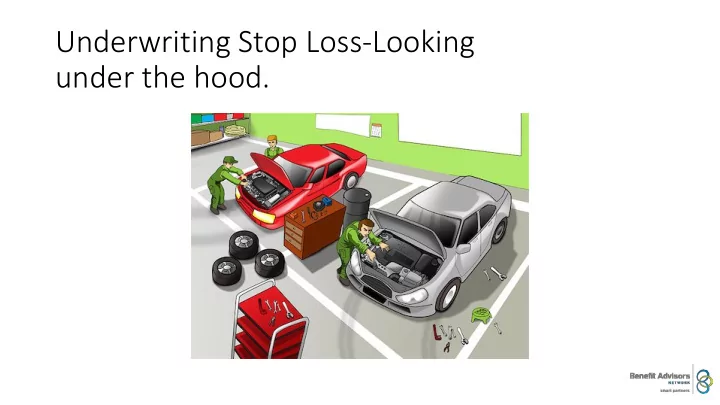

Underwriting Stop Loss-Looking under the hood.
Who is Pat Campola and what’s his experience to make this presentation?
Is it a Science, Art or Other Ted the underwriter Dave the Actuary
Specific Underwriting Components • Base Rate • Industry • Demographics • Trend • Plan Design • Network • Contract • Large Claim Assessment • Experience
Specific Base Rates and Estimated Claims • Medical charges are accumulated by data aggregators and sold to Carriers and Actuarial firms. • That data forms the basis that rates are developed from. • The more billed charges and people the data contains the more credible the rates will be. • Over time the base rates developed are a blend of the manual rates and the carriers actual experience. • A Stop Loss manual can cost up to $40,000 to $50,000 and revisions or updates are purchased every couple of years.
Target Claim Loss Ratio 65%-70% Administration 9-10% Premium Taxes- 2-2.5% Commissions- 12-15% Profit- 7-10% The manuals deal with raw claims from which various loads are added.
Industry Load Variance-.85 to 1.20 There are 10 Major SIC Division Structures listed by the Department of labor. • A. Division A: Agriculture, Forestry, And Fishing • B. Division B: Mining • C. Division C: Construction • D. Division D: Manufacturing • E. Division E: Transportation, Communications, Electric, Gas, And Sanitary Services • F. Division F: Wholesale Trade • G. Division G: Retail Trade • H. Division H: Finance, Insurance, And Real Estate • I. Division I: Services • J. Division J: Public Administration • Underwriters usually apply the SIC code listed in the S.E.C. data base. •
Area Factor • If a sample group of 500 lives was rated as if all employees were in Cleveland the area factor adjustment would be 0.992. • If the group was evenly split between Cleveland and Ft. Lauderdale the area factor adjustment moves to 1.123 a 13% increase.
Demographics • Gender paradox. While women have greater longevity then males, they have a higher morbidity than males. • Example-Rate adjustment factors assuming a population comprised of 50% male and female • Average age- 30- Factor adjustment .57 • 40- Factor adjustment .80 • 50- Factor adjustment 1.15
Plan Design Components • Deductibles/Coinsurance: • In hospital • Out Patient; • ER; • Rx; • Physician Services; • Lab; • Radiology; • In Network/Out of Network • Maternity
Network • One of the most important variables in plan costs; • Network discounts can range from 20% to 60% of billed charges; • The Medicare allowable is a consistent benchmark for comparison; • Carriers buy information on network discounts from aggregators and develop their own knowledge of the discounts over time.
Trend-Projection of future claim costs. • Components of Trend • Price Inflation • Deductible Leveraging • Utilization • Technology Advances • Cost shifting.
Contracts-Claims Eligible for Consideration base on incurred and paid parameters. • Example- $75,000 Deductible-500 employee lives • Specific • First Year Composite Annual Premium Expected Claims • 12/12- 148.26- 889,583 6,437,051 • 12/15- 169.27- 1,017994 7,420,221 • 12/24- 181.35- 1,088076 7,731,429 • Renewals • 15/12- 167.50 1,005,007 7,326,549 • 12/24- 181.35 1,088,076 7,731,429 • 24/12- 177.71 1,066,246 7,599,049
Large Claim Assessment • Malignant Neoplasm (Cancer) • Leukemia/Lymphoma/Multiple Myeloma • Chronic End stage renal Disease • Congenital Anomalies • Transplants • Premature Births • Septicemia (Infection) • Complications of medical surgical care • Cerebrovascular Diseases • Respiratory
Reinsurer Influence • Underwriting oversight- • Reinsurance agreements specifically state what business can be written and how rates are to be developed. Many agreements call for reinsurer approval for exceptions • Claims oversight- Depending on the dollars to be paid a second approval from the reinsurer is required.
Market Competitiveness Underwriters want to writer good business and will reduce the manual rate developed to a market rate. A market rate takes into account competitor rates they must compete against. The only manual rates that sell are on cases nobody wants. Each underwriter depending on their experience level can come off the manual rate up to their granted authority level. To exceed their authority level they need to receive permission and official sign off by their next level supervisor. There can be 3 or 4 level signoffs before the final rate is quoted.
Decisions that need higher level sign offs • Discounting manual more than 10%; • Industry Exceptions; • Minimum case size; • RFP with less than 2 years experience; • Aggregate margin less than 125%.
Environment- • Carriers can receive Up to 15,000 RFPs annually. • Not counting renews a production underwriter can produce 5 quotes daily. • Season Pressures- 60% of all business new and renewed is written on Jan. 1- Underwriters triage cases during this busy time. • Quote triage results in a 50% decline ratio. • Triage throws out RFPs that are incomplete, do not meet minimum underwriting guidelines, asking for an unrealistic turn around, coming from requesters that do not have business the the carrier. • Requesting a Quote and sharing renewal terms will tend to find the carriers most likely to sharpen their pen for the business. • Customer loyalty tends to sway at 7% above current or quoted.
Who Gets Favorable Decisions • Profitable Production Sources; • Large Volume Production Sources; • Potential Large Volume Production Sources; • Relationship Exceptions; • Trophy Cases.
Underwritings Future
The End-Thank You Have a good one Send me some RFPs
Recommend
More recommend